Henry Hanson M.D.: Biographical Essay of a Yellow Fever Fighter
South Dakota, Panama, Peru, Colombia, Nigeria, and Florida
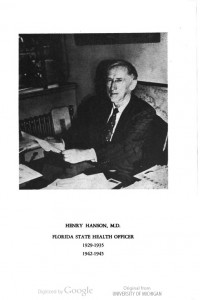
“Henry Hanson, M.D., Florida State Health Officer, 1929-1935, 1942-1945” [1]
Henry Hanson was born July 4, 1877 in Glenwood, South Dakota and credits his father for passing down a “pioneer spirit” that led him to “scientific and medical research.”[3] He received an A.B. in 1902 and an A.M. in chemistry in 1904 from the University of South Dakota. He then moved to Baltimore to pursue an M.D. at the Johns Hopkins University which he achieved in 1908. After briefly working in Milwaukee, in 1909, Hanson moved to Florida to become Director of the Division of Bacteriological Laboratories of the State Board of Health.[4]
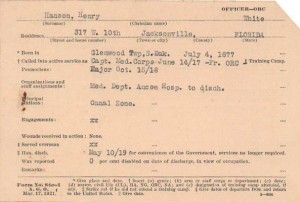
Henry Hanson, WWI Service Card. Courtesy of State Archives of Florida.[5]
When the U.S. entered World War I, Hanson joined the Army Medical Corps and was stationed in Panama for the duration. Hanson distinguished himself and was appointed Chief Sanitary Inspector of the Panama Canal Zone in 1918. When the Peruvian government recruited him in 1919, Hanson brought his family to Peru. He recounted their adventures in The Pied Piper of Peru: Dr. Henry Hanson’s Fight against “Yellow Jack” and Bubonic Plague in South America, 1919-1922 which was published posthumously in 1961 by the Florida Department of Public Health. Hanson also summarized this work in his diary, stating that there were almost 20,000 cases of yellow fever during this period and nearly two million house inspections and five million container inspections carried out in the massive campaign.[6]
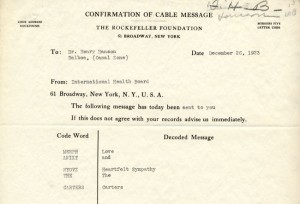
Telegram from the International Health Board to Henry Hanson, December 26, 1923, Hench-Reed Collection.[8]
After the successes in Peru, Hanson went to Colombia under the auspices of the Rockefeller Foundation International Health Board and the Colombian government to continue work on eradicating yellow fever and other tropical diseases. Hanson’s wife, Jane, and their two children, Martha and Karl, stayed in Panama. Jane was expecting the couple’s third child (Virgil), and sadly passed away in childbirth. Hanson wrote in his diary on the anniversary of his wife’s death: “El dia mas triste de mi vida el 19 diciembre 1923.” (Translation: The saddest day of my life on December 19, 1923).[7] After their meeting in Peru, Hanson and Henry Rose Carter formed a close friendship with each other, and the two families often spent time together. The Carters sent the above telegram following Jane’s death on behalf of the International Health Board.
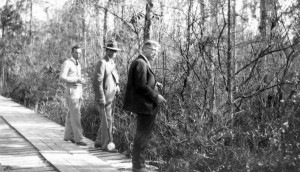
Dr. Henry Hanson, State Health Officer (1929-1935) at right, conducting rodent eradication in Florida, ca. 1930. Courtesy of State Archives of Florida.[12]
Hanson’s struggle in deciding to join the West Africa Yellow Fever Commission only a couple of years after his wife’s death is shown through letters to Dr. Carter: “While I am becoming somewhat reconciled to this individual existence puttering along with one specimen after another I still ‘feel the call of the wild’ and should like to be out fighting again.”[9] Hanson spent the majority of his time in Southwestern Nigeria focused on work with over 5,000 house visits in twenty-two months. After returning to the United States in 1927, Hanson and his family moved to Florida where he accepted a position with the Bureau of Communicable Diseases, State Board of Health of Florida. He became the State Health Officer in 1929 and served two terms from 1929-1935 and 1942-1945.[10]
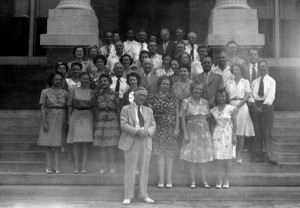
State Board of Health staff photo in Jacksonville, Florida. Hanson is center front, September 15, 1945. Courtesy of State Archives of Florida.[13]
In the intervening years, Hanson worked as the traveling representative of the Pan-American Sanitary Bureau 1936-1942.[11] Dr. Hanson’s focus on public health issues included rodent eradication (perhaps recalling the “burning of Paita” when he burned houses to kill rats and thus end a bubonic plague outbreak in the Peruvian town of Pieta in 1920) and establishing statewide mosquito control efforts. After his very successful career, Dr. Hanson retired in 1945 and moved to Jacksonville, Florida. He passed away at age 76 on February 13, 1954. Five years later, in 1959, the Florida State Board of Health laboratory building in Jacksonville was named “The Henry Hanson Building” in his honor.[14]
![]() Previous: Introduction / Next: Dr. Hanson’s Personal Diary
Previous: Introduction / Next: Dr. Hanson’s Personal Diary ![]()
- [1] Henry Hanson, The Pied Piper of Peru: Dr. Henry Hanson’s Fight against “Yellow Jack” and Bubonic Plague in South America, 1919-1922, ed. Doris M. Hurnie (Jacksonville, Fla.: Convention Press, 1961), frontispiece, http://hdl.handle.net/2027/mdp.39015010649146?urlappend=%3Bseq=6 (accessed July 25, 2012).
- [2] Letter from Henry Hanson to Henry Rose Carter, August 7, 1925, Hench-Reed Collection, Historical Collections, CMHSL, University of Virginia, http://search.lib.virginia.edu/catalog/uva-lib:2223703 (accessed May 17, 2017).
- [3] Henry Hanson, The Pied Piper of Peru: Dr. Henry Hanson’s Fight against “Yellow Jack” and Bubonic Plague in South America, 1919-1922, ed. Doris M. Hurnie (Jacksonville, Fla.: Convention Press, 1961), iii, http://hdl.handle.net/2027/mdp.39015010649146 (accessed July 25, 2012).
- [4] Henry Hanson, The Pied Piper of Peru: Dr. Henry Hanson’s Fight against “Yellow Jack” and Bubonic Plague in South America, 1919-1922, ed. Doris M. Hurnie (Jacksonville, Fla.: Convention Press, 1961), iv, http://hdl.handle.net/2027/mdp.39015010649146 (accessed July 25, 2012).
- [5] “Henry Hanson,” WWI Service Card, State Archives of Florida, Florida Memory, http://www.floridamemory.com/items/show/198279 (accessed July 25, 2012).
- [6] Henry Hanson, Diary, November 14, 1925.
- [7] Henry Hanson, Diary, December 19, 1925.
- [8] Telegram from the International Health Board to Henry Hanson, December 26, 1923, Hench-Reed Collection, Historical Collections, CMHSL, University of Virginia, http://search.lib.virginia.edu/catalog/uva-lib:2223482 (accessed May 17, 2017).
- [9] Letter from Henry Hanson to Henry Rose Carter, April 12, 1923, Hench-Reed Collection, Historical Collections, CMHSL, University of Virginia, http://search.lib.virginia.edu/catalog/uva-lib:2223277 (accessed May 17, 2017).
- [10] William J. Bigler, “Public Health in Florida – Yesteryear,” Reprinted with permission from Florida Journal of Public Health 1, no. 3 (May 1989), http://fpha.org/resources/Documents/public%20health%20in%20florida-yesteryear.pdf (accessed May 23, 2017).
- [11] “Ecuadorean Government Honors American Doctor,” New York Times, Oct. 3, 1938.
- [12] “Dr. Henry Hanson, State Health Officer (1929-1935) at right, conducting rodent eradication in Florida, ca. 1930,” State Archives of Florida, Florida Memory, http://floridamemory.com/items/show/44612 (accessed July 25, 2012).
- [13] “State Board of Health staff photo in Jacksonville, Florida,” September 15, 1945, State Archives of Florida, Florida Memory, http://floridamemory.com/items/show/44850 (accessed July 25, 2012).
- [14] Henry Hanson, The Pied Piper of Peru: Dr. Henry Hanson’s Fight against “Yellow Jack” and Bubonic Plague in South America, 1919-1922, ed. Doris M. Hurnie (Jacksonville, Fla.: Convention Press, 1961), Acknowledgments, http://hdl.handle.net/2027/mdp.39015010649146 (accessed August 15, 2012).